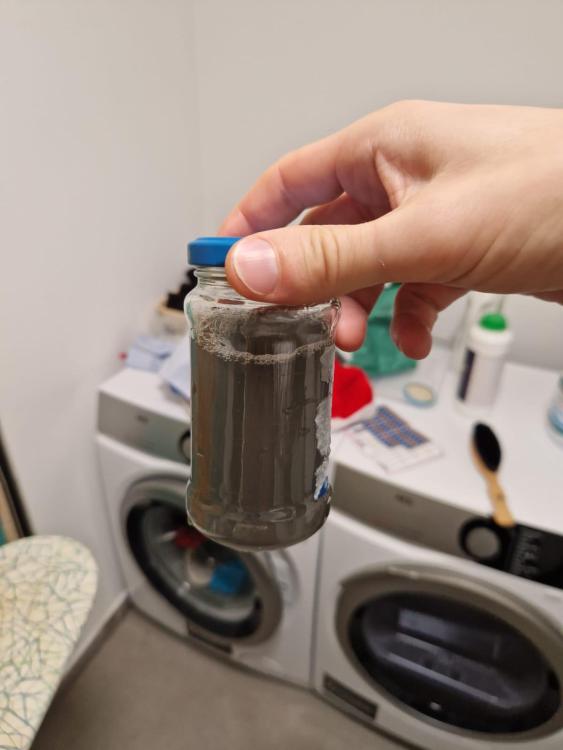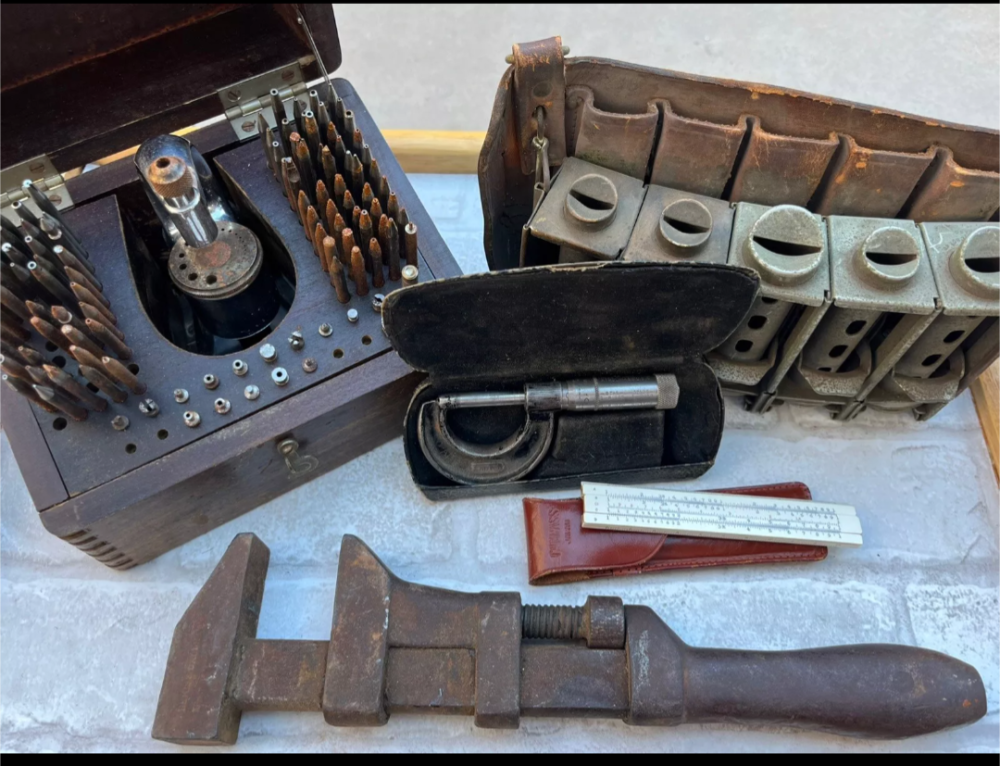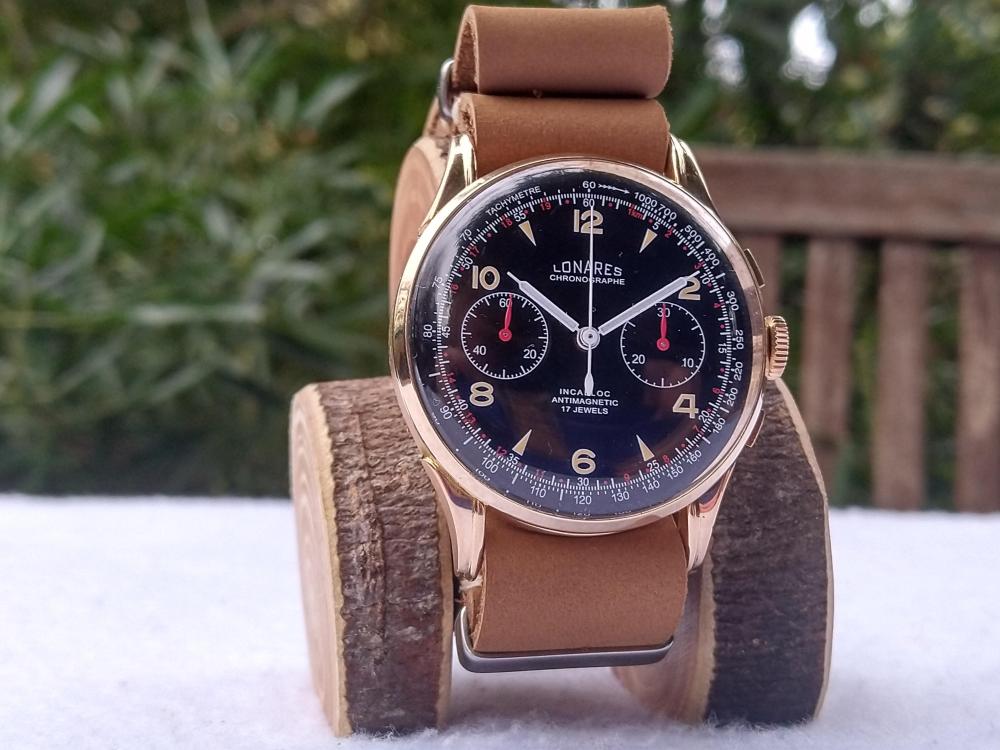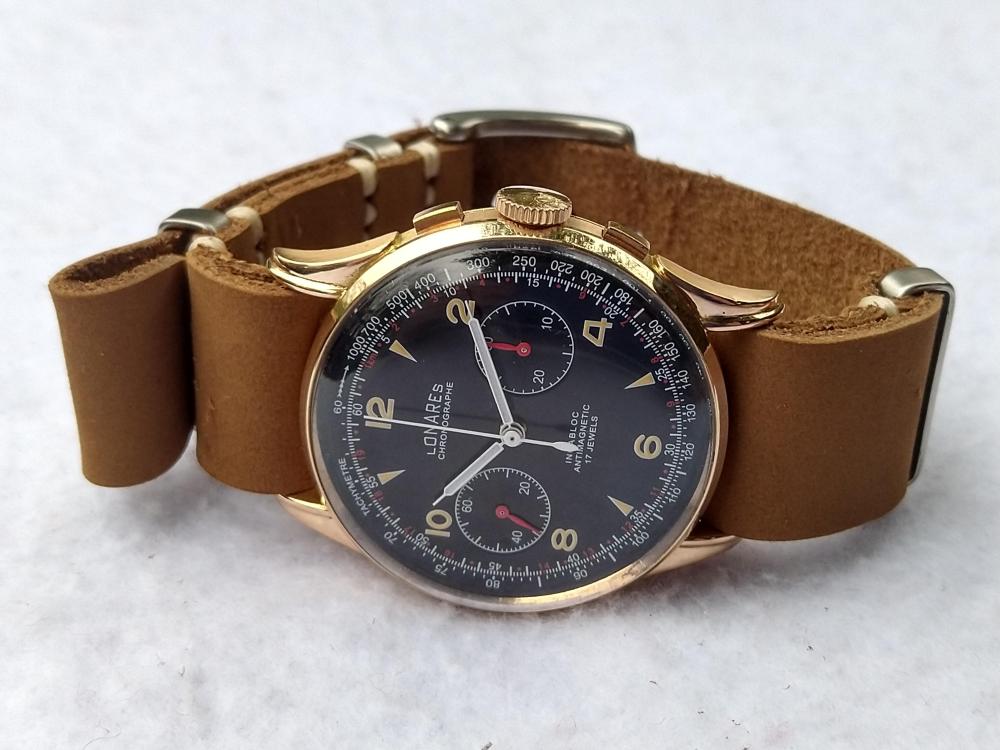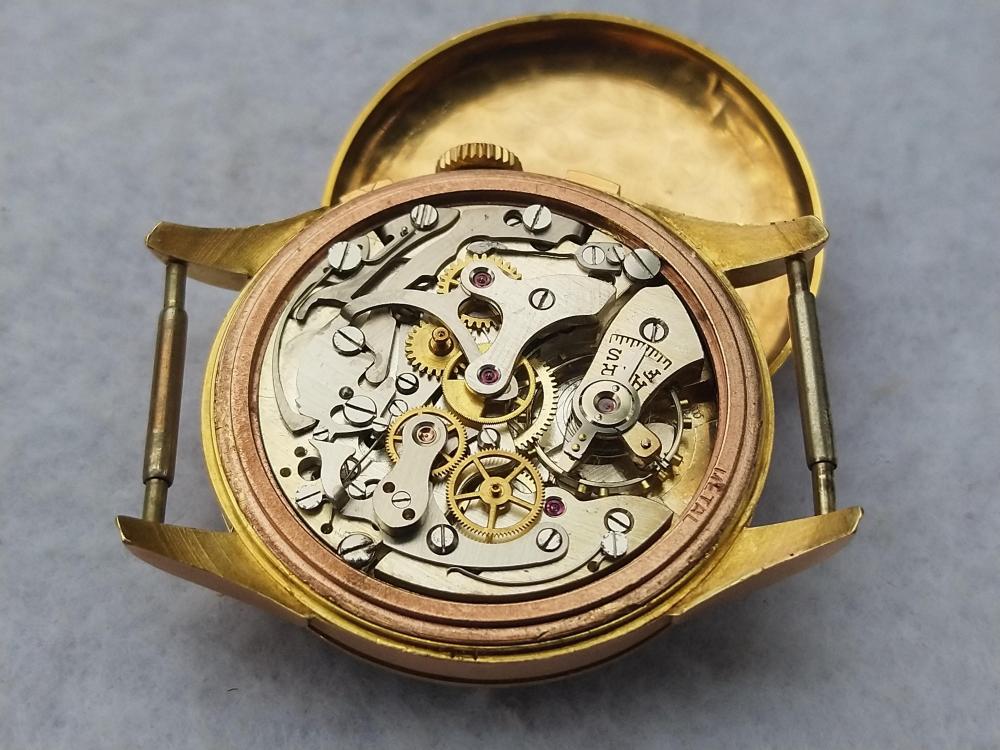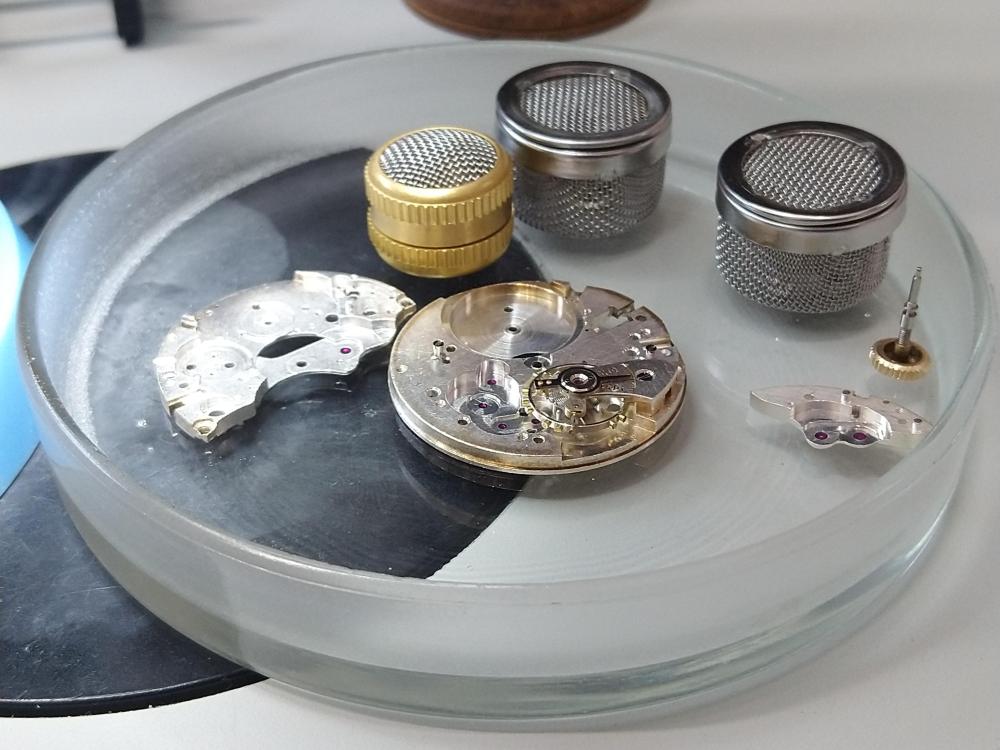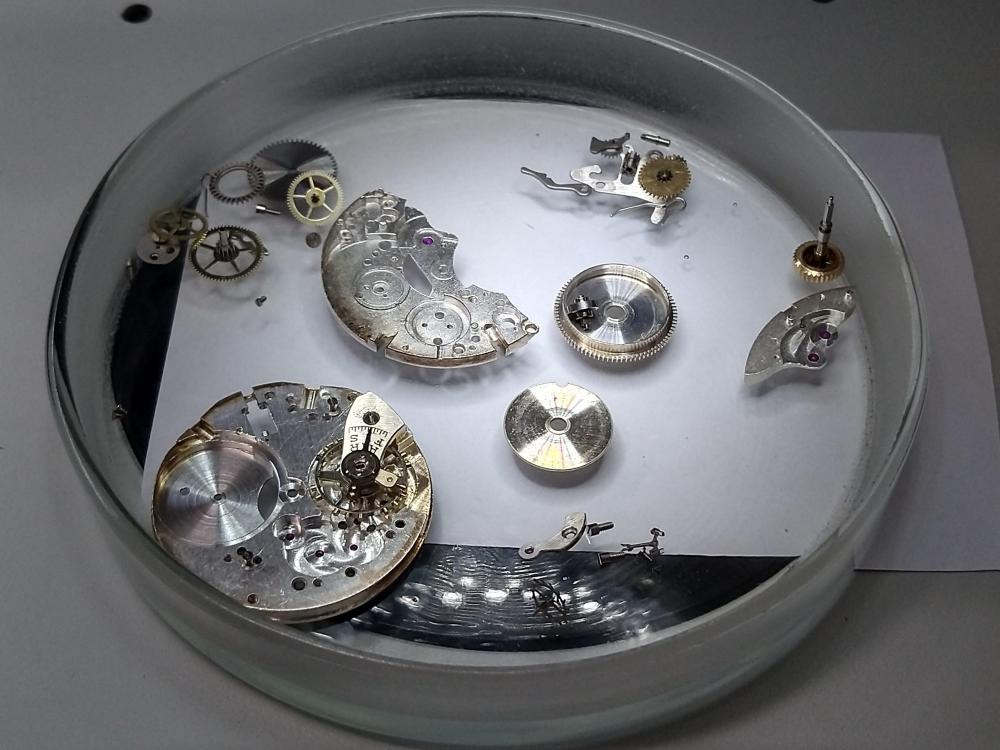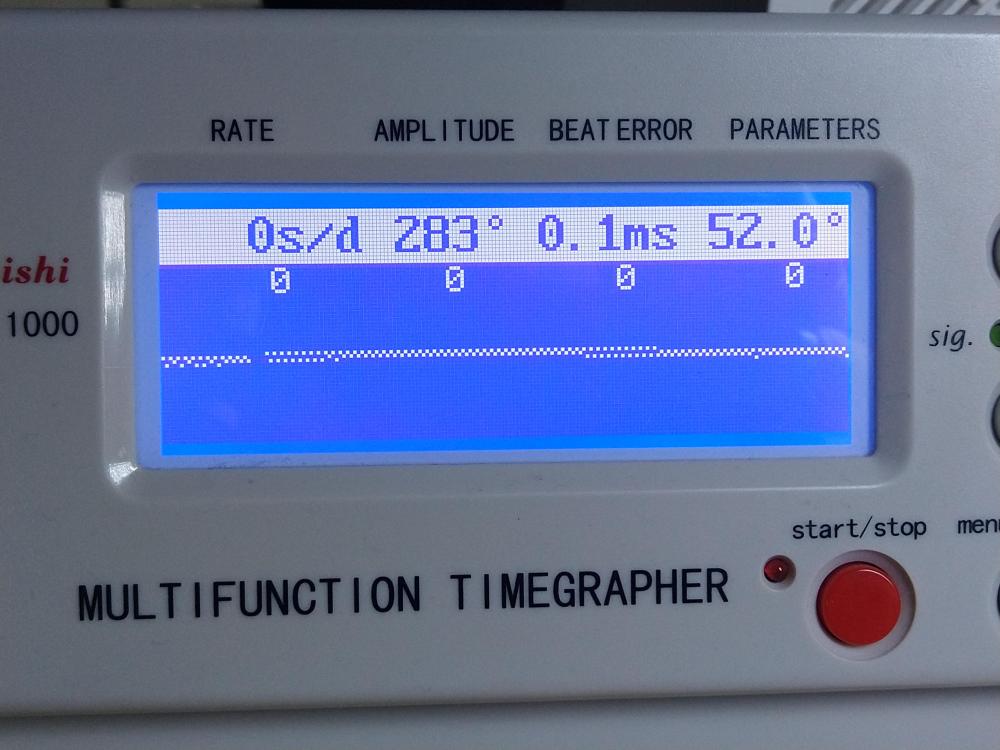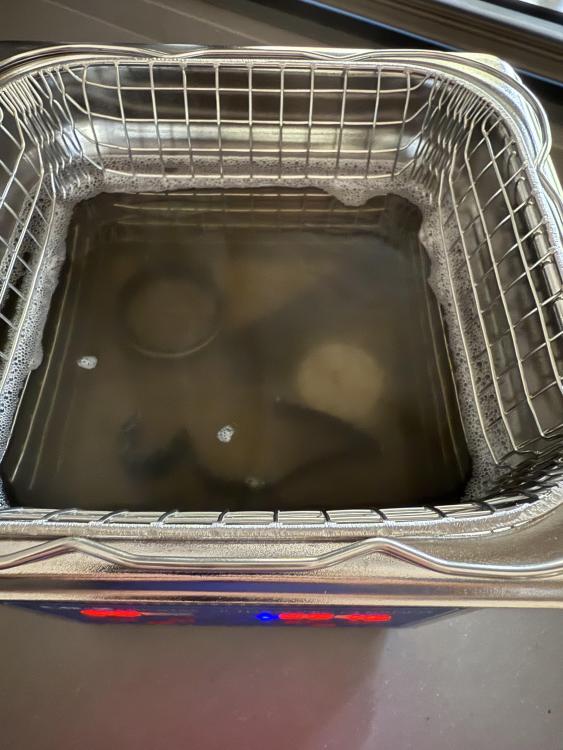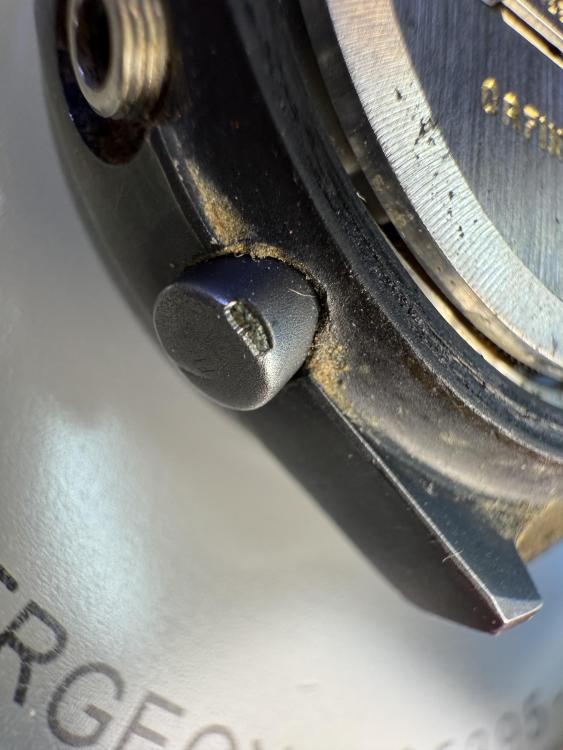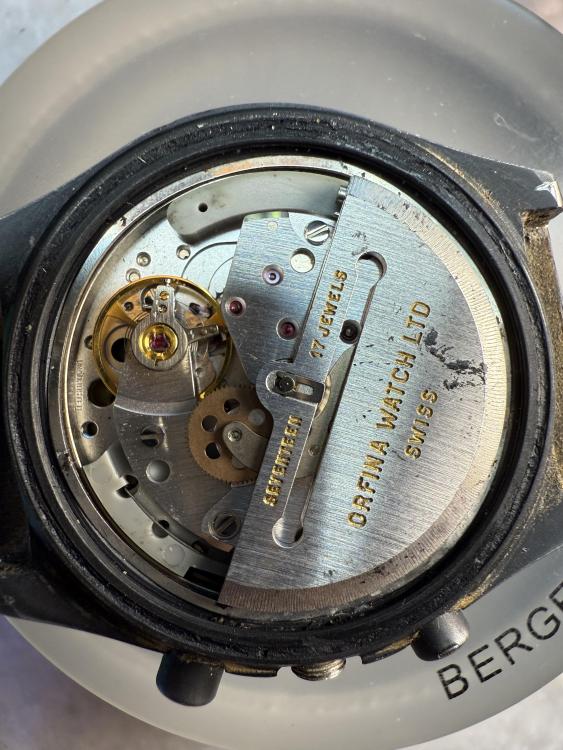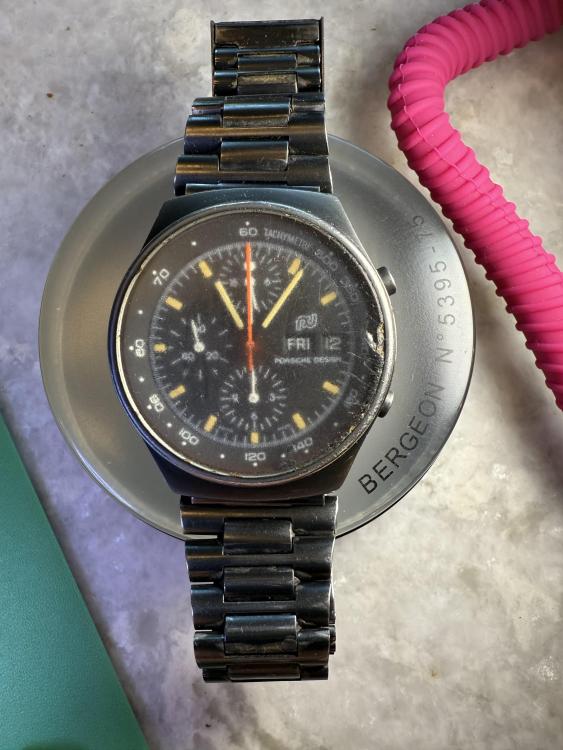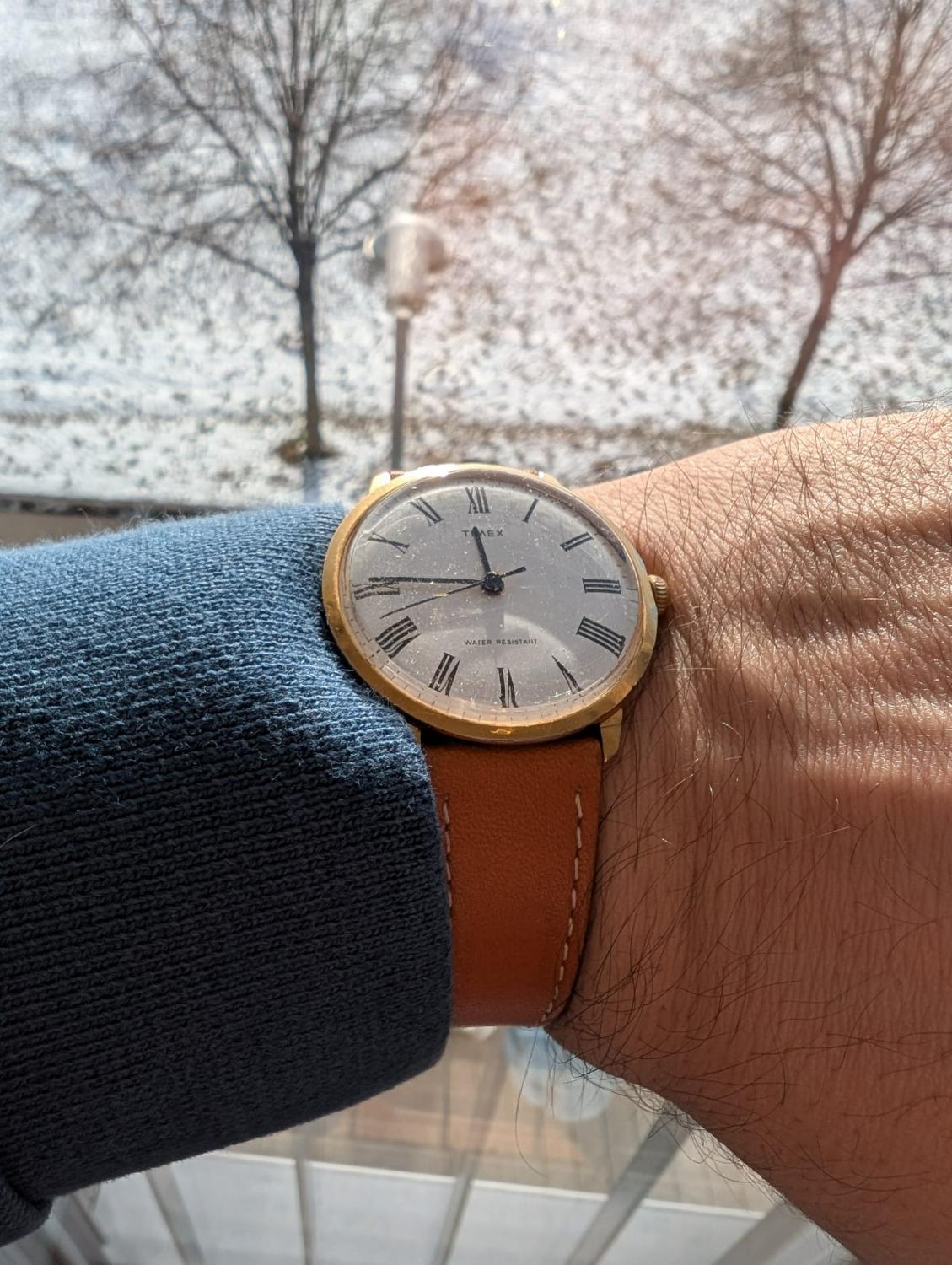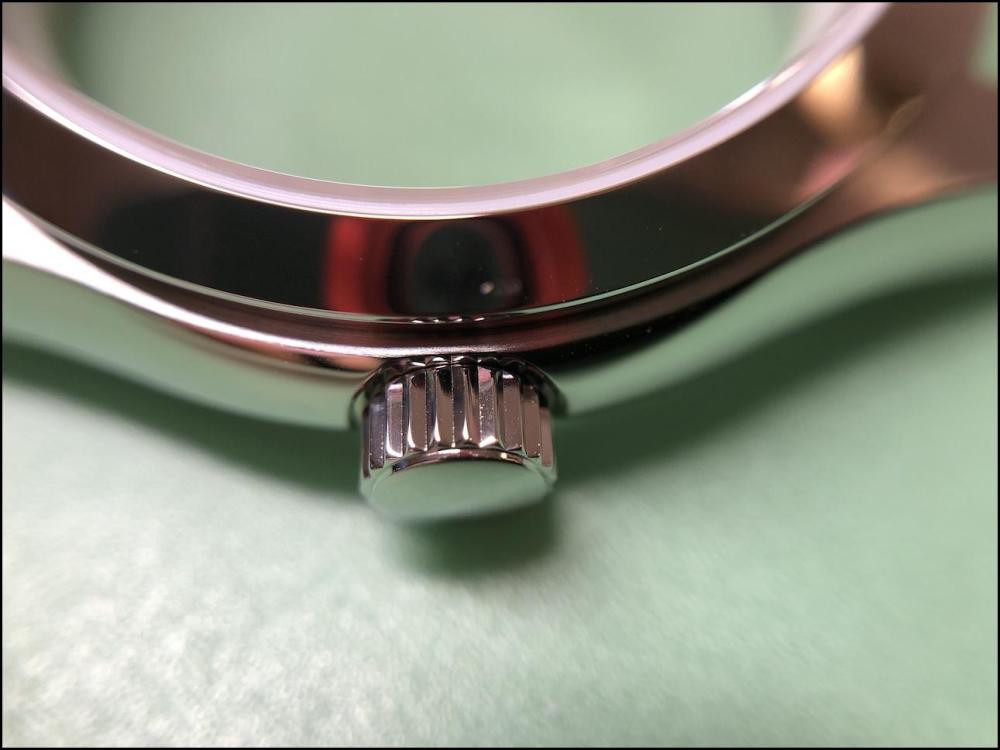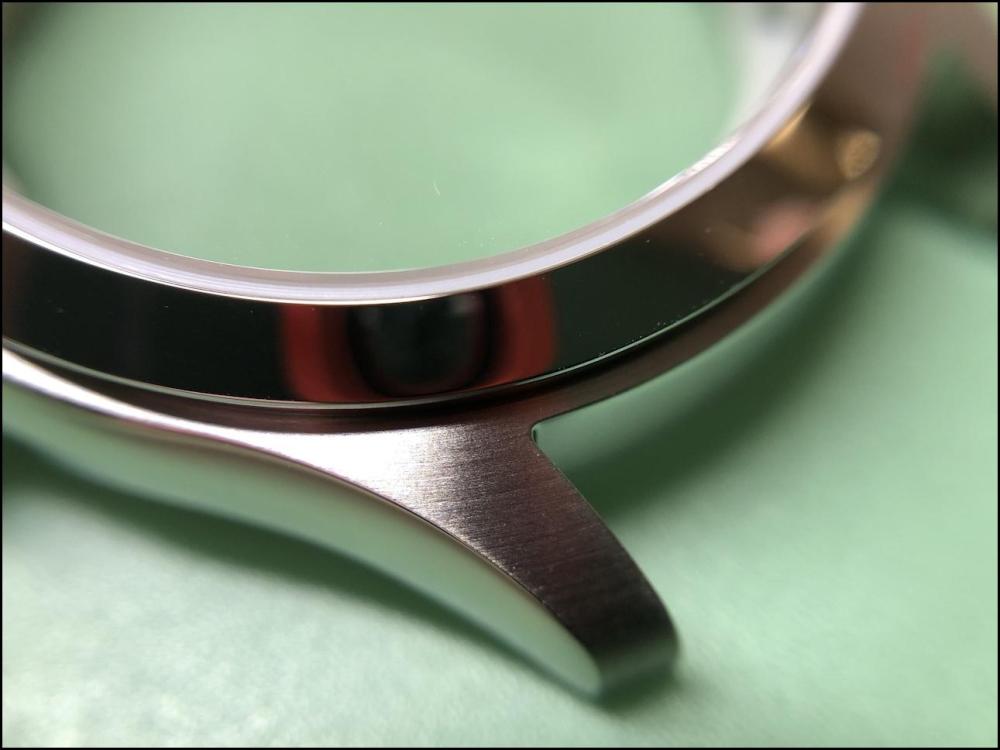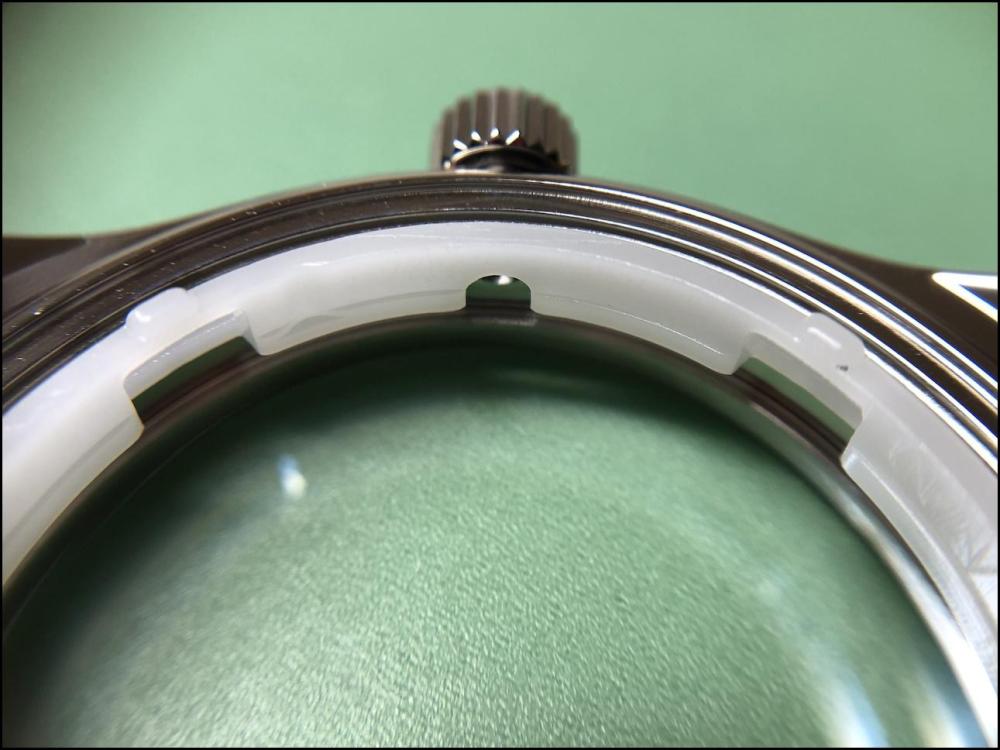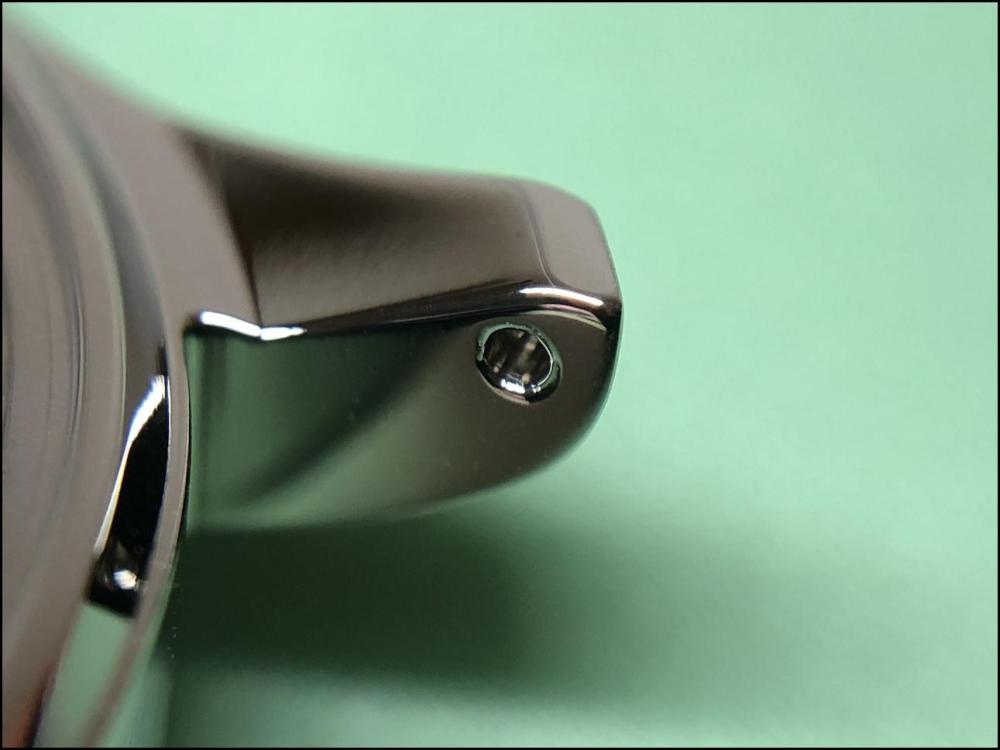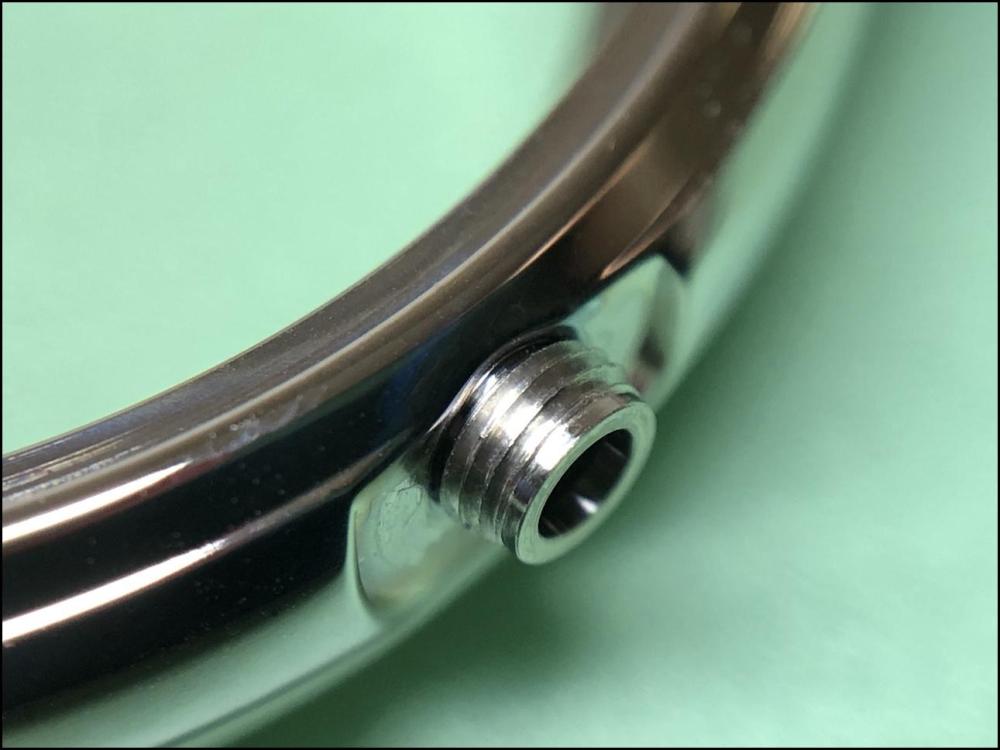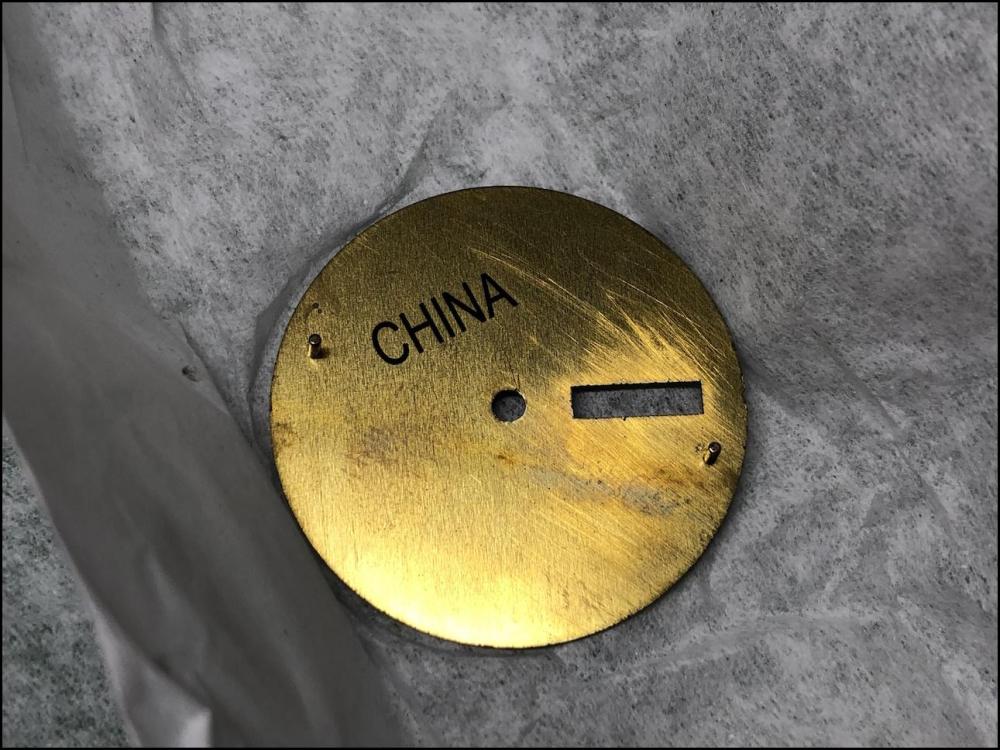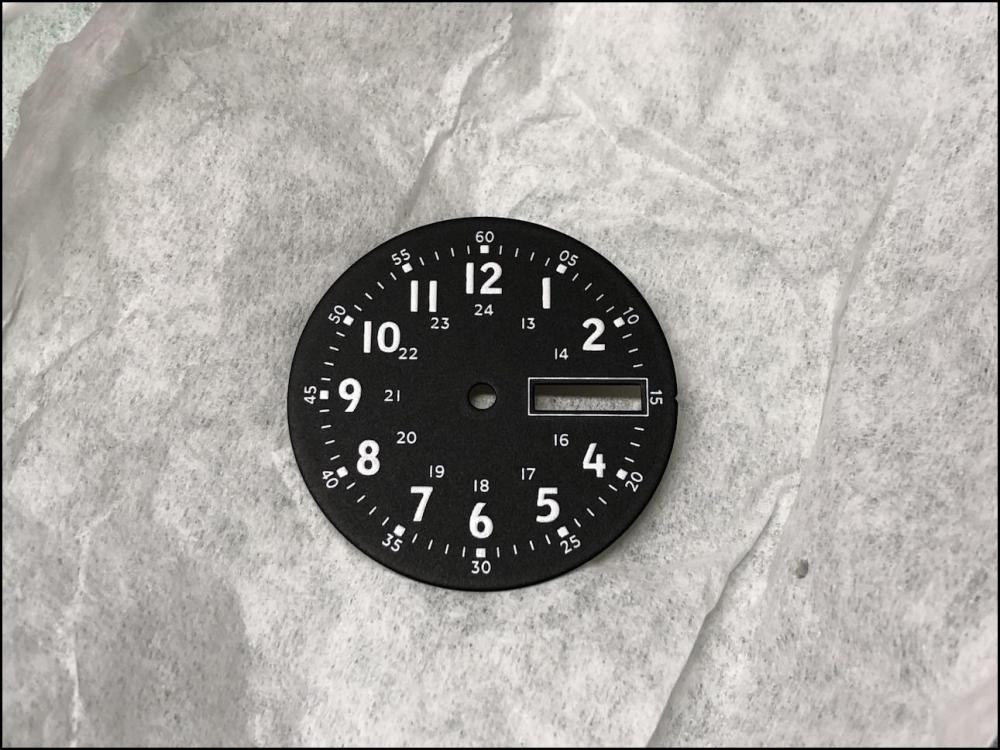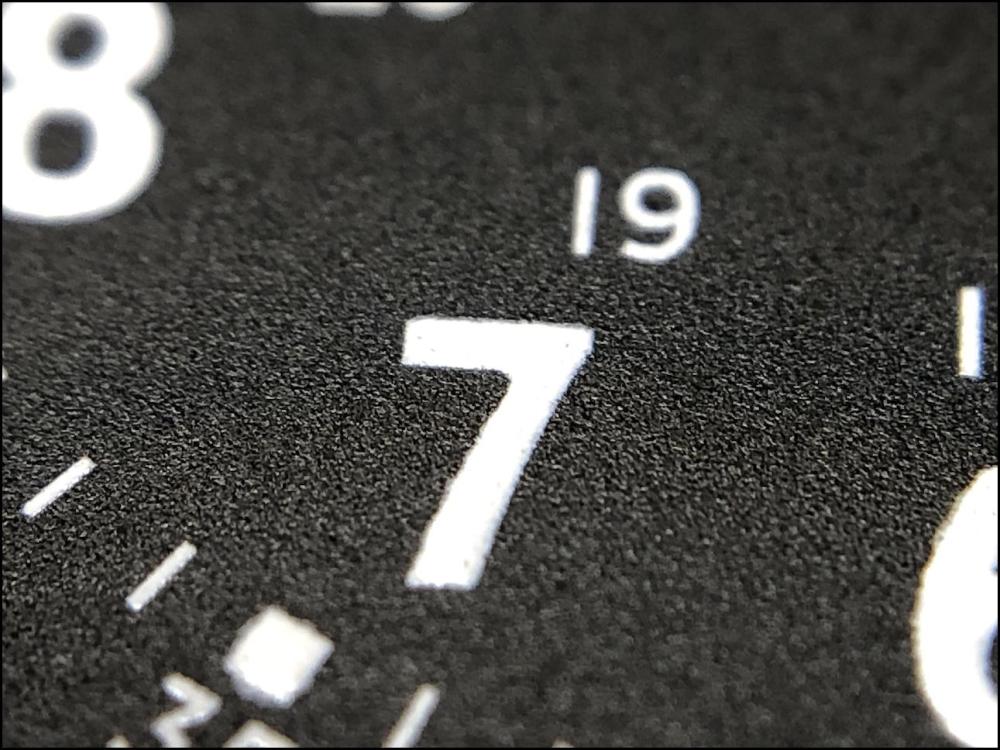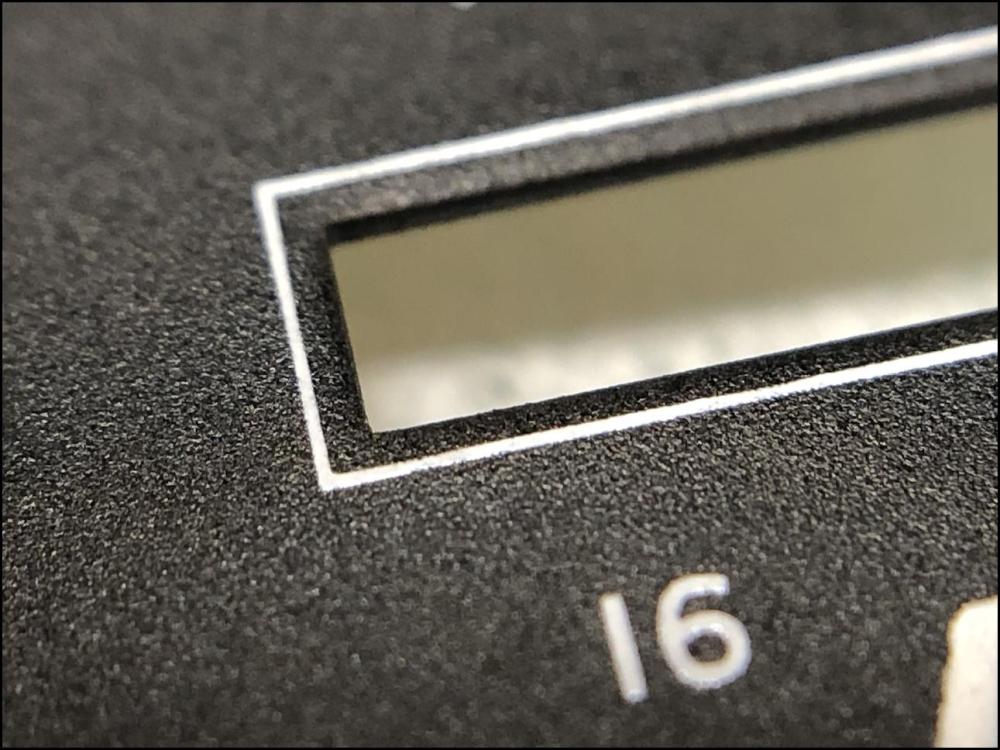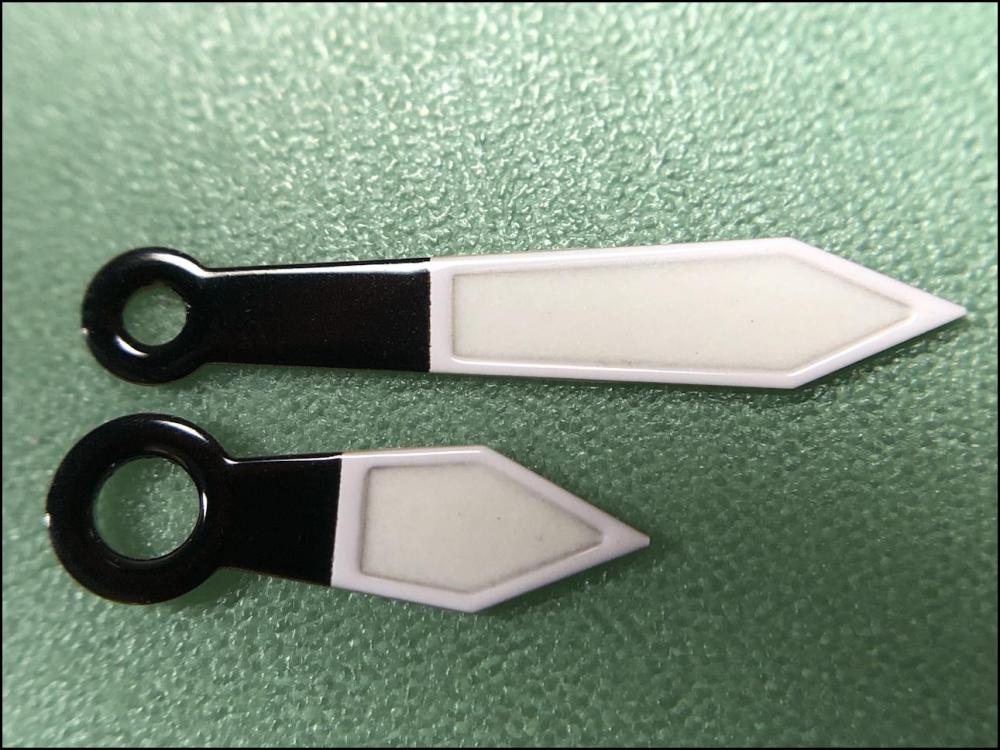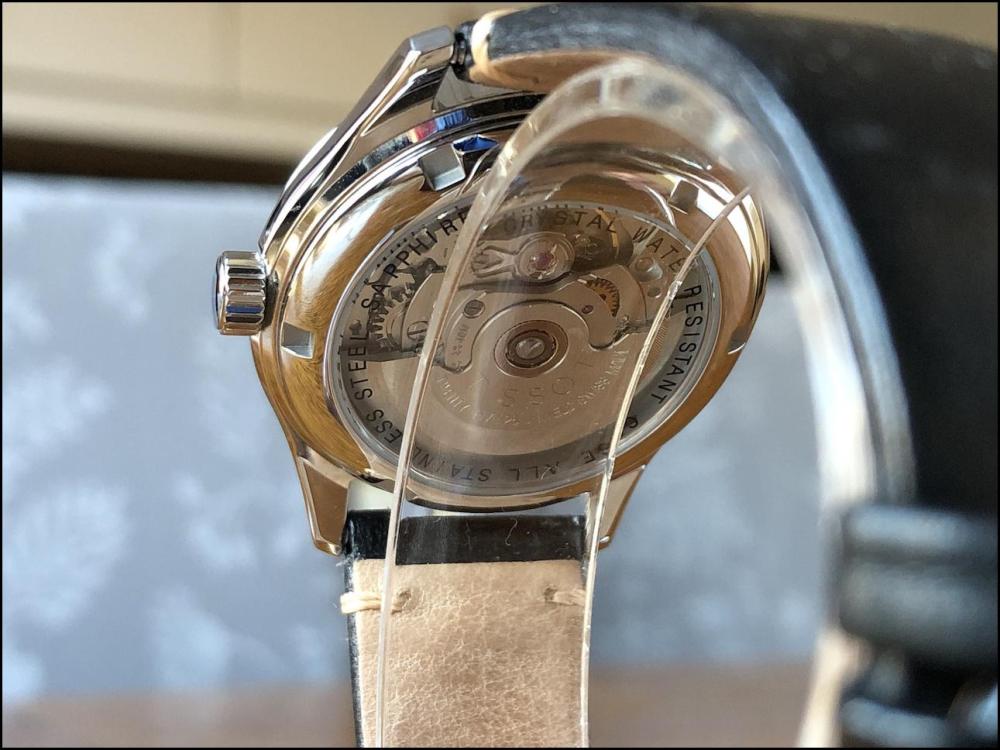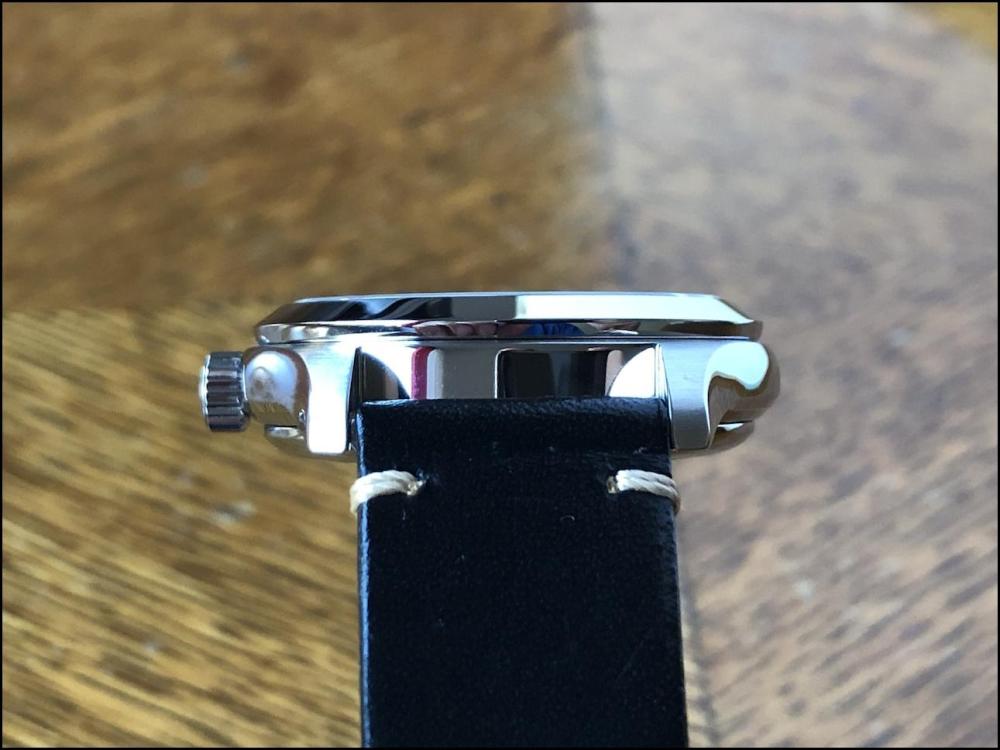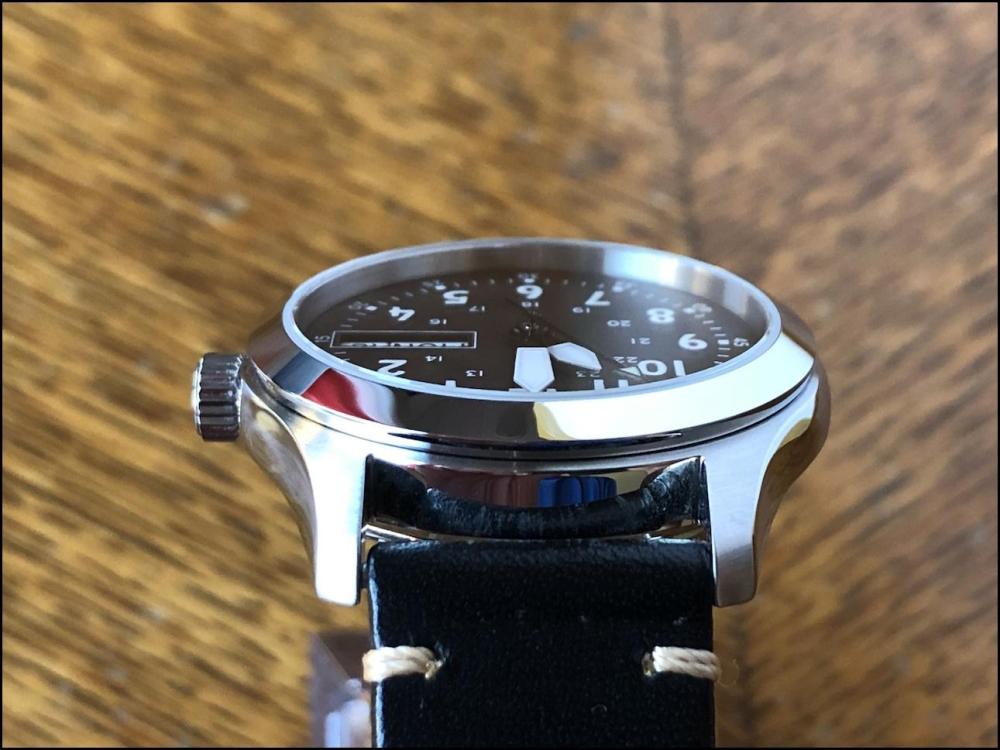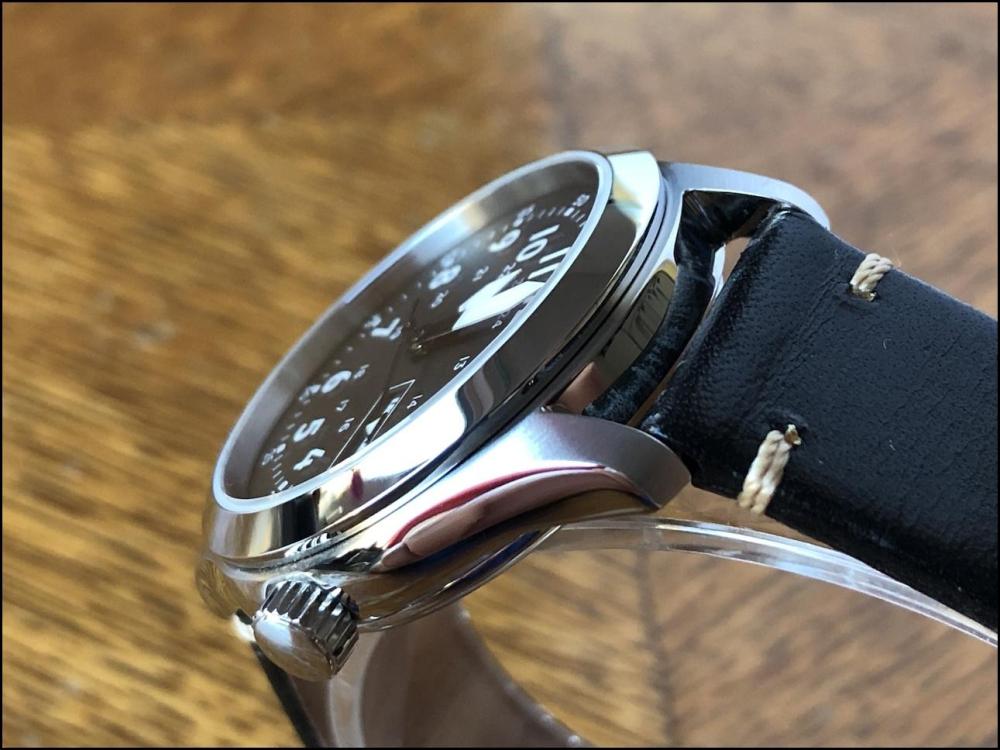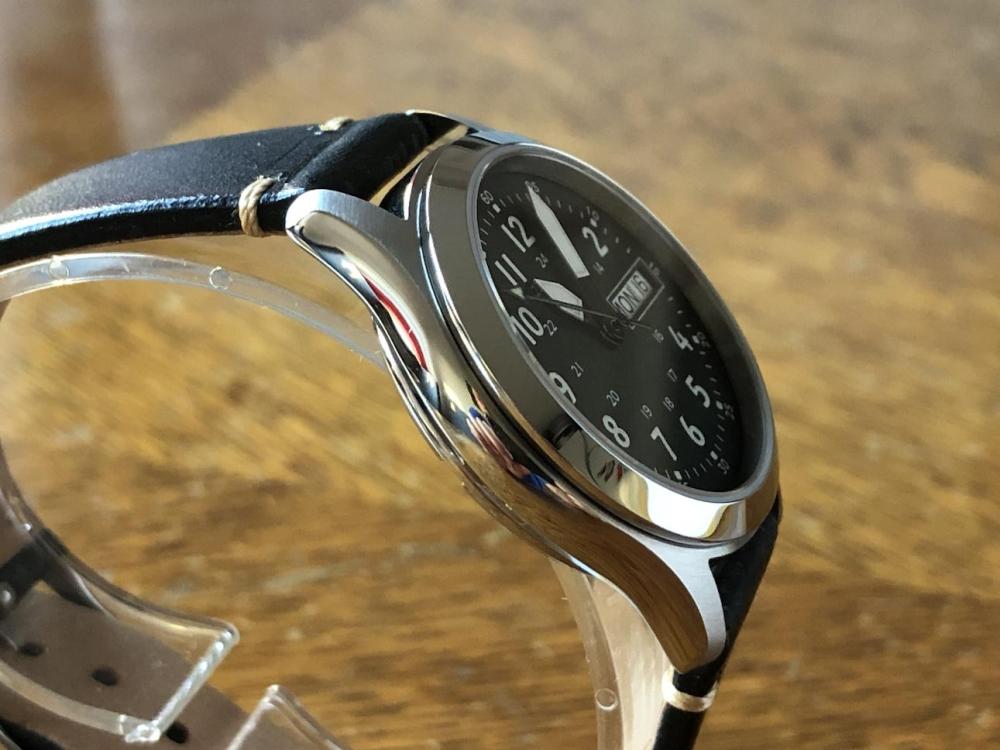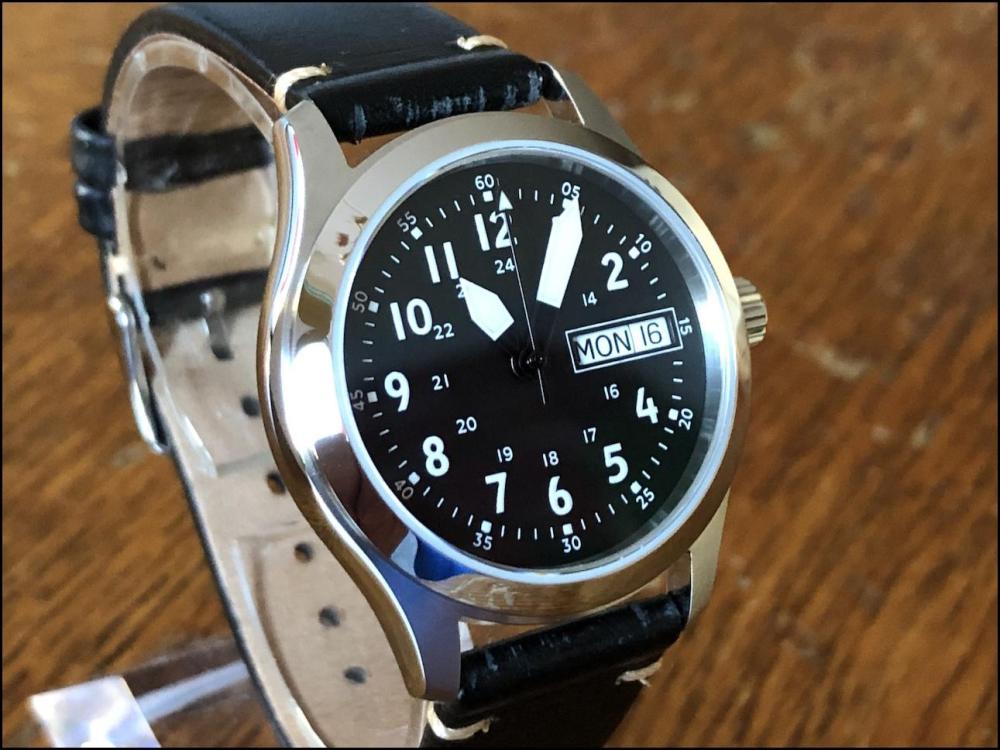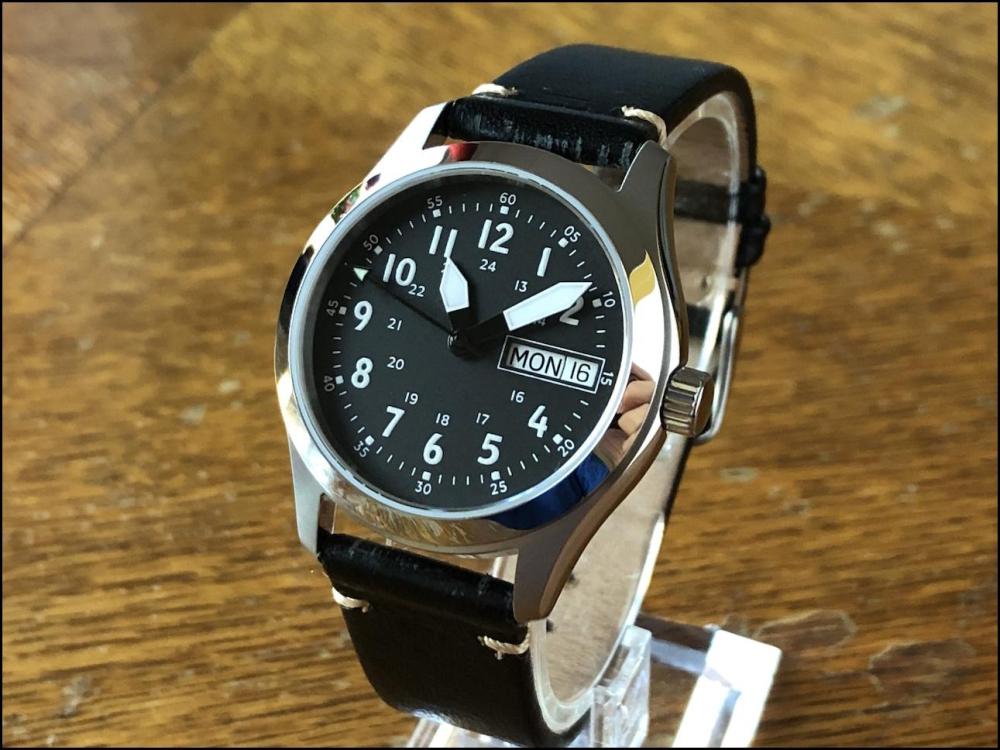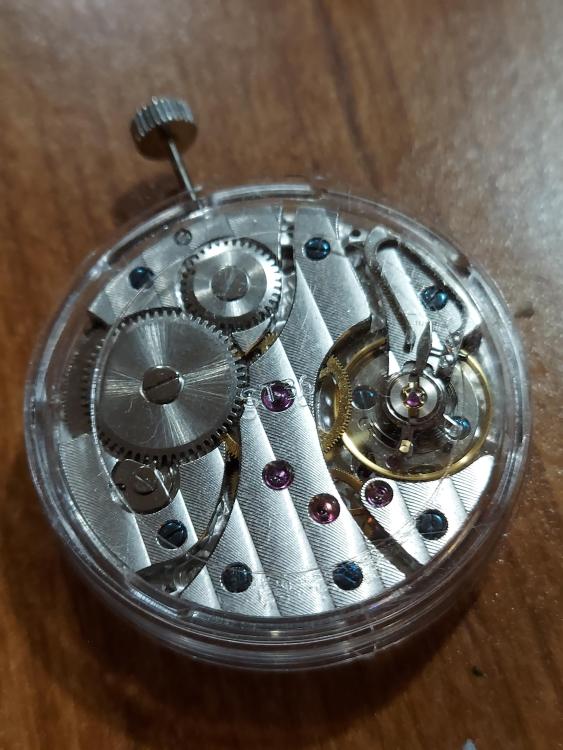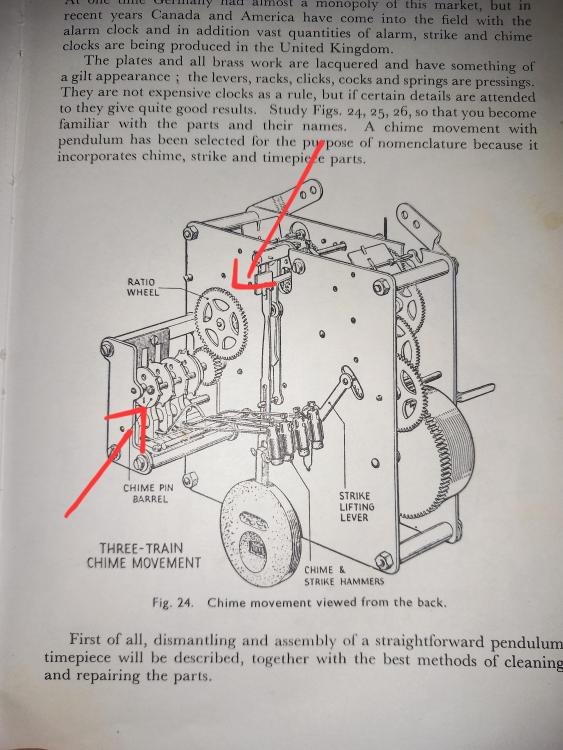Leaderboard
Popular Content
Showing content with the highest reputation on 12/17/24 in Posts
-
I recently picked up a Seiko Kinetic from eBay that was described as "second hand moves when shaken. I managed to revive the battery and started cleaning the watch. It has to be the dirtiest bracelet I've ever come across. The links felt "gummy". So I let it soak in a beaker of ultrasonic cleaning solution for 30 minutes before turning on the ultrasonic. This is what came off. I couldn't even see the bracelet anymore. And the huge pieces of gunk swimming in the solution. Yucks.3 points
-
Lots of farms around where I worked and loads where I now live. One I had was an old watch dropped in cow shit, the famer did wash it off before he brought it to me but muck had got inside and it was all in the expanding bracelet which broke. Have you got a few tadpoles in that jar?3 points
-
Hi there - Time to start troubleshooting individual function groups of the watch. First test: remove the balance and pallet fork. If you apply a little wind to the mainspring, does the train spin very freely and stop with a little bit of recoil back the other way? That would indicate your train is clean enough and no pivots damaged (plus other potential issues). Lack of recoil isn't necessarily a bad problem, but if the escape wheel stops suddenly then there is probably an issue. And if the train is sluggish to stop and sort of sputters along once the wind is nearly out, then you have some friction in the train that needs attention. Second test: install the balance but do not install the pallet fork. Turn the balance 180° and let it go, allowing it to oscillate freely. You should be able to count around 100 oscillations, indicating that the balance is free enough. If it doesn't swing for very long, you need to examine balance pivots and the balance jewel lubrication. There are other potential faults here too, end shake, hairspring touching something (though your photo looks pretty good)2 points
-
2 points
-
Thanks so much, Rixy. Took the movement out & followed your guidance: only needed to move the barrel through one set of pins. Was consequently able to take clock back to owner & set it up for her. She's texted to say she's so pleased to hear the Clock going again: the sound takes her back to her childhood when she last heard it! Very satisfying....Thanks again. Thanks, Michael: You have a good teacher!2 points
-
Maybe not so high up in the evolutionary chain but there were definitely stuff moving around.2 points
-
2 points
-
HWGIKE#31 Landeron 48. Full service, nice performance (not the correct lift angle though). Dial and hands are new the old ones were battered and not complete. Ps.: Stephen, I got your watches. I have two more in my queue and then I plan to put one of yours into the 100. I just thought that it would be funny to send you a message here.1 point
-
1 point
-
That was a rhetorical question Andy1 point
-
Actually, I found another one but it looks in a better shape than mine. Let's see who will be donating pieces to whom if I manage to win that auction1 point
-
1 point
-
The seller must be desperate for some money as it's Christmas.1 point
-
I'm a bit confused by this. The usual Westminster chime requires only four notes, and can be played on four chime rods. This list specifies 7 chime rods. Also the first quarter usually is played in descending sequence ( 1234 or 4321, depending on which direction you have numbered the rods.) I just tried playing those notes on the piano, and they don't sound like any chime I have heard before. Could this be referring to some other chime sequence? This one seems more like the chime sequence with which I am familiar.1 point
-
Yes they did. They used a metal oxide resistor instead of a carbon one.1 point
-
I think that if 4321 is the descending scale then 1 will be the longest rod. The clock is four chimes ahead and resetting is not difficult. You can try to do it with the movement still in the case, which I'll describe first. But it is likely you will need to take the movement out to do it. To correct it without removing it from the case, stop the clock and move the time round to quarter past and let it play its incorrect sequence. Depending what the make is, there will be a way to disengage the chiming system from its train. Usually you need to remove a wheel on the outside of the back plate. If you can do without removing the movement you are lucky! Once disengaged, manually turn the barrel (with pins or studs on) and listen as the hammers hit the bars. As soon as you hear the descending scale, stop and reconnect the hammer system to the train by replacing the wheel. If you have to take the movement out you do the same as above but will need to look for the descending sequence rather than listen for it. If your chime rods are in ascending order then look out for 4321. Now reconnect the system to the train and run it a few times. Check that the last hammer of every sequence drops (they can stay high and dry if you didn't move the barrel enough) and check also that when it goes into warning (a couple of minutes before it chimes) that the hammers don't lift (if they do it means you moved the barrel too far). Like Andy asked, send some pictures and we can give clearer guidance. OH, I played those notes on the piano - not a tune I recognise!1 point
-
A few years ago, when I was still relatively new to the service and repair field, I found an intact but non-functioning ETA 2836-2 calibre movement in a bag of watch parts I had purchased at an auction for about 30 US dollars. That movement has now found its home in the Ofrei watch shown in the pictures. Apart from the movement and the strap, I bought all the parts (case, hands, and dial) from the American website Ofrei.com. It cost me about 200 US dollars, nearly half of which was spent on shipping, import fees, and European taxes. As a non-American, I still feel it was worth the money. If I had been American, I would have found it exceptionally affordable. The first time I disassembled the movement, the obvious and seemingly only issue was a black, sticky "gunk" on the pallet fork's impulse surfaces. At the time, I had no idea what caused this black and sticky "gunk." Now I believe, though I’m not entirely sure, that it was epilame that had somehow degraded or gone bad. Despite great efforts, I couldn’t clean the pallets, and I ended up buying a new one. Even so, the watch didn’t run very well. A couple of years later, with more knowledge and experience, I disassembled the movement again but found no obvious issues. I serviced the movement again and adjusted the side shake and end shake of all the wheels as precisely as I could in the hope that it would help, but it didn’t. Then, a few months ago, I decided to take the movement apart a third time, and this time I finally found the reason for the irregular and poor timekeeping: micro-oxidation and micro-rust on almost all the wheel pivots. Barely visible even at 40x magnification. I brought out my Jacot tool, and the problem was finally solved! This wasn’t the first time the Jacot tool had brought one of my movements from either poorly functioning or somewhat acceptable performance to function as if it were brand new. The Jacot tool requires a significant investment, not least in acquiring the knowledge and training to use it, but it has once and for all proven to be worth the money and effort. The decisive moment for me was when @nickelsilver showed me how to hold the burnisher properly. For those of you who want to know more, you can click on this link: "How to hold a Jacot tool burnisher" So, why buy a case, hands, and dial from Ofrei.com instead of from eBay, where a "stainless steel" case from China usually costs less than 50 US dollars? If you ask me, the answer is that Chinese cases on eBay are junk and a scam. The three I’ve purchased in total all had numerous issues, the most serious being that they rust (stainless steel, really?) and cause skin problems since I’m allergic to nickel!!! Less serious but still annoying is that the movement fits poorly in the case and that the threads are generally poorly made. There are several issues with these cases, but what I’ve described here should suffice. No more Chinese cases from eBay for me! Are Ofrei’s cases manufactured in the USA, Germany, or Switzerland? I don’t know. They’re probably made in China as well, but at least there’s a contractor (Ofrei) who knows their stuff and has quality-controlled their deliveries. It may not be Rolex quality, but the case is symmetrical and carefully polished, and the case back fits the case like a glove (buttery smooth!). The dial is perfectly symmetrical, and the hands are straight and well-made. Best of all, all the parts fit together perfectly with the movement. I’m so satisfied that I felt it was my duty to share my experiences. I hope someone finds it useful!1 point
-
Well here's my two penneth worth, Bench mats, now I have used a hobby cutting mate and then rectangular foam squares bought from Hobbycraft for years, but i thought I would treat myself to a Bergeon Plastic mat from cousins, well I'm dissapointed to say the least, I have moved it to my machining bench where it will live out its days. Onto Aliexpress and i find a dealer selling Horotec bench mats for £8,95 plus postage ( bit cheeky ) but for £20 all in I thought i'd take punt and see what comes, Well I wasn't disappointed, even beat a part I'd ordered from the states via UPS first class. Anyway, its exactly the same as a genuine one, I know this as my mentor has one and I had to do a comparison. the seller name is Shop1102893212 Store and they currently have a 4.8 rating so not bad.1 point
-
All the other watches I have so far are broken in one way or another- which is why I got them for free- so I haven't been able to get them working yet (need a staking set, etc). However, I did get a practice movement that I just took apart completely and reassembled. And if runs. I feel like it's a milestone.1 point
-
You might try ebay for a donor watch. That might get you a crystal and the ring.1 point
-
Usually any time I see the arrow symbol on A British watch I do think of army as I think it's their symbol.1 point
-
My master taught me with a westminster chime on the quieter past the hammers go down the scale and on the quieter too as it chimes three times the last also goes down the scale. When setting these clocks up when it comes to the warning no hamer should start to lift and after it has chimed no hamer should be stuck. The way to sort this is to unscrew the ratio wheel and adjust.1 point
-
Hi there. If I have misunderstood, please ignore my response. When the second hammer stops, is that on a particular quarter? If that is the hammer next to the lowest note then it should sound last on the half-past and the o'clock (I think - have been humming it in my head). If you nudge the chime pin barrel and it behaves again, it could be that you need to reset the position of the barrel. The reason it stops 'up' and doesn't go again is perhaps because there just isn't enough power to budge it when it tries to move again (it needs to gain momentum to get going and being stuck, it doesn't get the chance). I have attached a diagram that might help. What I would do is loosen the ratio wheel, that will free the chime pin barrel, then move the barrel round in its direction of travel (clockwise) a small way (one tooth). Then retighten the ratio wheel. It should then play and clear the last hammer. I'm sure there will be lots of help with this.1 point
-
As a retired dentist, I'm very familiar with mercury. Can you actually see droplets of mercury around the pendulum? If you can, sprinkle sulphur powder over it, open all doors and windows and let it stand overnight. Then use a small brush and carefully clean up the area. Mercury is toxic. Just one small droplet is enough to saturate the air in an enclosed room. I moved away from using dental mercury in my practice more than twenty years ago. But there are some situations where amalgam is the only material suitable for the restoration. Hence I had to keep a small supply of it. I used to store my mercury in Tupperware containers in a drawer at my clinic. And after some time, the edges of the drawer would develop a strange grey stain. It can be cleaned off with some effort but it kept coming back. I suspect the stain is caused by mercury vapors. A study showed that dental staff have a higher level of mercury in hair and nail samples when compared with the general public. A friend of mine sent me an amalgam mixing machine (amalgamator) for repair many years back. When I opened up the machine, there was a puddle of mercury inside. I quickly closed it back and disposed of the machine. I quickly informed my friend and she went for a hair and nail sample test for mercury. It was found that she had seven times the safe limit of mercury in her body! But the good news is; she's still alive and appears fine. Recently, a nice crystal regulator clock came up for auction on eBay. I was really tempted but after much deliberation, I decided I wasn't going to have mercury in my house. I've heard of people converting their mercury pendulums to gallium, which is safer. Or maybe we just don't know enough about gallium toxicity. Gallium looks a lot like mercury, except it's solid at room temperature. It has a melting point of about 30°C. A piece of gallium would melt and look like mercury if held in the palms of your hand. And now with global warming, where temperatures above 30°C are getting common, gallium looks like a real viable replacement for the mercury in crystal regulators.1 point



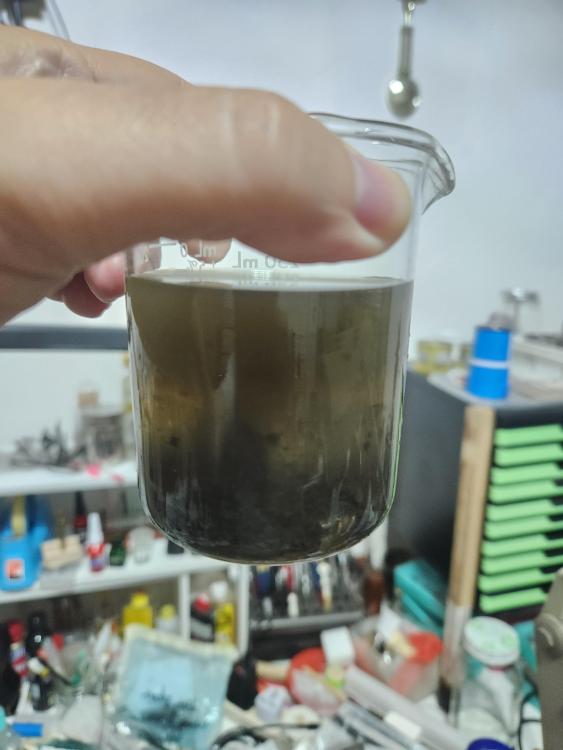
.thumb.jpg.cb17a66989f1e796fd4217db2e9ca9df.jpg)
